
| Project Home | About the Scans | Browse Gallery | Image Map | Support Data | Resources | Ephemeris |
Featured Image - 07/31/2019
Apollo 9: Moon Lander in Earth Orbit

Every Apollo Moon landing mission depended on four major space vehicles. One was the white and black Saturn V, the most powerful rocket ever flown. The Saturn V launched the other three major Apollo space vehicles into space. They were the Command and Service Module (CSM), the Lunar Module (LM), and another "vehicle" which is not usually considered a spacecraft (but which was sometimes called one — more on that in a moment).
The CSM, the Apollo lunar mission mothership, included the drum-shaped Service Module (SM) and the conical Command Module (CM). The silver SM was partly visible near the top of the Saturn V during launch; the CM was hidden beneath a protective white conical shell with a pencil-shaped Launch Escape System (LES) tower on top. The LES was designed to pull the CM to safety from before Saturn V liftoff until it was jettisoned at an altitude of 55 miles.
The CM included launch and reentry couches for three Apollo astronauts, control panels, a round docking port with an extendible probe docking unit, a heat shield for safely reentering Earth's atmosphere, and parachutes for descent to an end-of-mission ocean splashdown. The SM included the powerful Service Propulsion System (SPS) main rocket engine, four attitude control thruster quads, tanks containing volatile ignite-on-contact (that is, hypergolic) propellants, tanks for liquid oxygen and liquid hydrogen, and fuel cells for combining oxygen and hydrogen to make electricity and water.
The LM reached space inside a tapering, streamlined shroud beneath the CSM. The LM was the first — and so far only — U.S. crew-carrying spacecraft designed to land on another world.
The LM was made up of the Descent Stage and the Ascent Stage. The Descent Stage included the Descent Propulsion System (DPS) rocket engine, tanks for hypergolic propellants, batteries, a landing radar, four spindly landing legs, a small platform nicknamed "the porch," and a ladder leading from the porch down one landing leg to the lunar surface.
The Descent Stage became the launch pad for the Ascent Stage when the time came for the astronauts to return to the CSM in lunar orbit. The Ascent Stage included a round docking port on its top with a funnel-shaped drogue docking unit, the Ascent Propulsion System (APS) rocket engine, four attitude-control thruster quads, tanks containing hypergolic propellants, batteries, a crew compartment for two astronauts, control panels, a hatch opening onto the porch, and two triangular windows for viewing the surface during landing.
The last of the four Apollo lunar landing space vehicles — the one not usually thought of as a spacecraft — was the white Apollo A7L lunar space suit with its Portable Life Support System (PLSS) backpack. NASA sometimes called the Apollo space suit and PLSS a spacecraft because it could operate independent of the CSM and LM. During lunar landing missions, the A7L and PLSS would allow astronauts to step outside the LM and explore the Moon.
Apollo 7 (11-22 October 1968) tested the CSM in Earth orbit. Apollo 8 (21-27 December 1968), the first piloted mission to launch on a Saturn V, had been intended to test the LM in Earth orbit; the Moon lander was, however, not yet ready, so NASA took the bold step of launching its CSM to the Moon. Not until Apollo 9 (3-13 March 1969) did astronauts test the Saturn V, CSM, LM, and A7L space suit with PLSS together in space.
This "photo essay" shines light on Apollo 9 through photographs its crew captured during their 10-day flight. They used seven cameras and several kinds of film, including infrared-sensitive film for Earth-observation photography. All images in this post were selected from the nearly 2000 Apollo 9 in-flight photos available for viewing on the LROC March to the Moon webpage.
Apollo 9 photographs — in particular, photos of its LM — have a unique color palette. Only during Apollo 9 did an LM fly with a CSM in Earth orbit. In place of austere gray, white, and tan lunar craters, mountains, and plains, the Apollo 9 LM flew against a backdrop of blue seas, white clouds and ice, green vegetation, and tan and orange deserts.
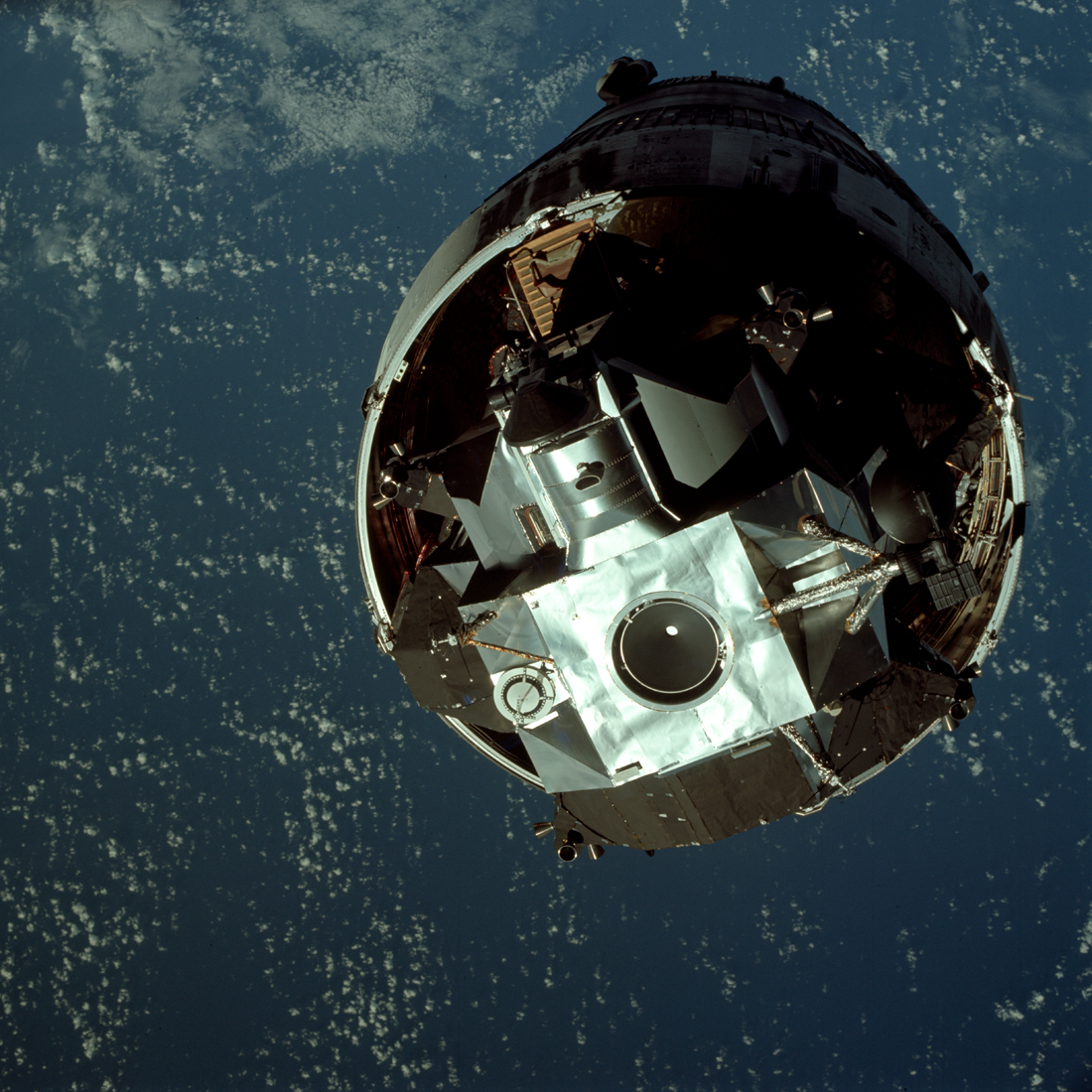
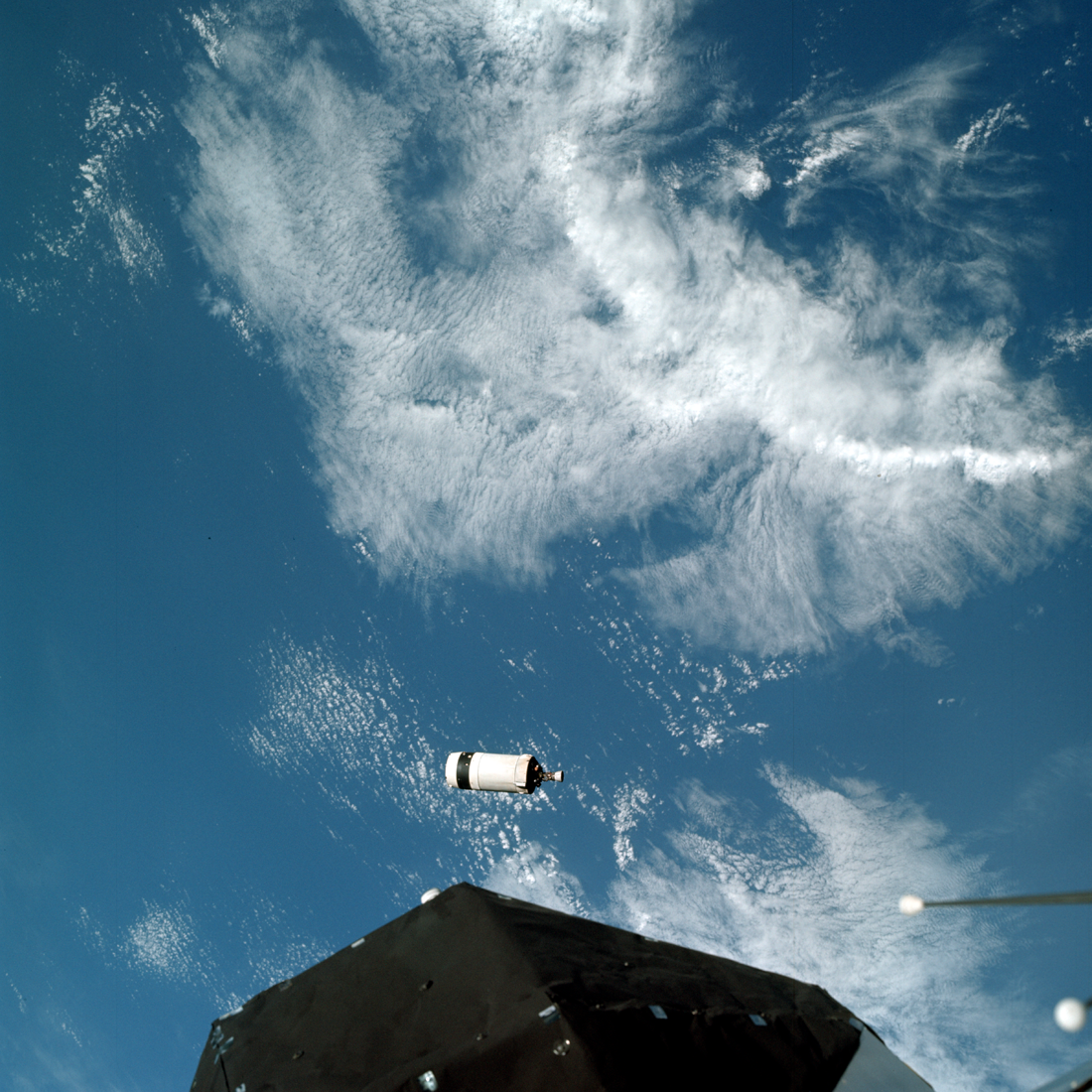
The Apollo 9 Saturn V rocket, the fourth to fly, lifted off from Kennedy Space Center Launch Pad 39A and rapidly disappeared into thick clouds. Eleven minutes later, the Apollo 9 crew of Commander James McDivitt, Command Module Pilot (CMP) David Scott, and Lunar Module Pilot (LMP) Russell Schweickart arrived in low Earth orbit. They detached their CSM from the shroud linking it to the Saturn V S-IVB third stage, then used its attitude-control thrusters to turn it end-for-end and dock with the top of their LM spacecraft. A little more than an hour later, the CSM pulled the LM away from the Saturn V S-IVB stage.
Because Apollo 7 and Apollo 8 had each included only a CSM, their radio callsigns could be "Apollo 7" and "Apollo 8" without causing confusion. Flying two piloted spacecraft simultaneously meant that Apollo 9 needed two callsigns. The mission's CSM was given the callsign Gumdrop for its shape and for the clingy blue plastic wrapper that had protected it during shipment from its manufacturer. The LM, with its spindly landing legs, had been nicknamed "the bug" when development began in mid-1962. McDivitt, Scott, and Schweickart called their LM Spider.
The first half of the planned 10-day mission was devoted mainly to spacecraft testing. Eating and sleeping on a regular schedule took a back seat to maneuvering tests and spacecraft system checks because most checks and maneuvers had to take place when Spider and Gumdrop were within radio range of a ground station or U. S. Navy tracking vessel.
NASA was understandably eager to test whether the CSM could maneuver safely with the 14,530-kilogram LM docked to its nose, as it would need to do several times during each Apollo lunar landing mission. McDivitt, Scott, and Schweickart ignited Gumdrop's SPS main engine five times while docked with Spider. To everyone's relief, the connection between the two spacecraft remained firm.
McDivitt and Schweickart boarded Spider on 5 March for the first time to test a maneuver everyone hoped Apollo astronauts would never have to perform. Still docked with Gumdrop, they fired Spider's DPS rocket engine for six minutes and 12 seconds to show that it could, if necessary, stand in for a failed CSM SPS engine. Less than a year later, the crew of Apollo 13 (11-17 April 1970) would use the DPS engine on the LM Aquarius to put themselves on course for Earth after an explosion in their CSM, the Odyssey, scrubbed their planned lunar landing mission.
The Apollo 9 flight plan included the first spacewalk of the Apollo Program. Wearing an A7L space suit and a PLSS backpack, Schweickart would climb out through Spider's hatch onto the porch and place his feet in a foot restraint nicknamed the "Golden Slippers." He would then use handrails and handholds to climb over the outside of Spider to Gumdrop. The spacewalk was meant to test the A7L and PLSS ahead of their use on the Moon and to demonstrate that astronauts in the LM could safely transfer to the CSM if the internal "tunnel" through the docking units that linked the spacecraft could not be cleared after docking.
The EVA plan went awry, however; Schweickart became "space sick" and vomited twice. Now called Space Adaptation Syndrome (SAS), spacesickness was a mystery in 1969. SAS was not much noticed during Mercury and Gemini, the first two U.S. piloted space programs, but during Apollo, larger spacecraft cabins gave astronauts more room to move around. With greater mobility came opportunities for large head and body movements and disorientation, the main SAS triggers.
At first, astronauts avoided talking about SAS out of concern that they might be considered unfit for spaceflight assignments. In the Skylab, Space Shuttle, and International Space Station eras, however, NASA discovered that more than half of all astronauts experience SAS symptoms during their first 10 days in space.
Apollo 8 astronauts suffered from SAS during their flight to the Moon in December 1968, but they chalked it up to flu and tried to ignore it. Schweickart did not have that luxury; throwing up in a space helmet could be life threatening. Unsure how to proceed, McDivitt discussed the matter with doctors in Mission Control, for the first time throwing a spotlight on SAS. He admitted to feeling a little nauseous himself. Scott, on the other hand, showed no sign of sickness.
NASA canceled the Apollo 9 spacewalk, but Schweickart felt better, so a short spacewalk to test the A7L and PLSS on Spider's porch went ahead. After he got his bearings on the porch, Schweickart felt well enough to test handrails, remove thermal test samples from Spider's exterior, snap photos, and test a TV camera. At the same time, Scott opened Gumdrop's hatch and photographed Schweickart. The first Apollo spacewalk lasted about 40 minutes.
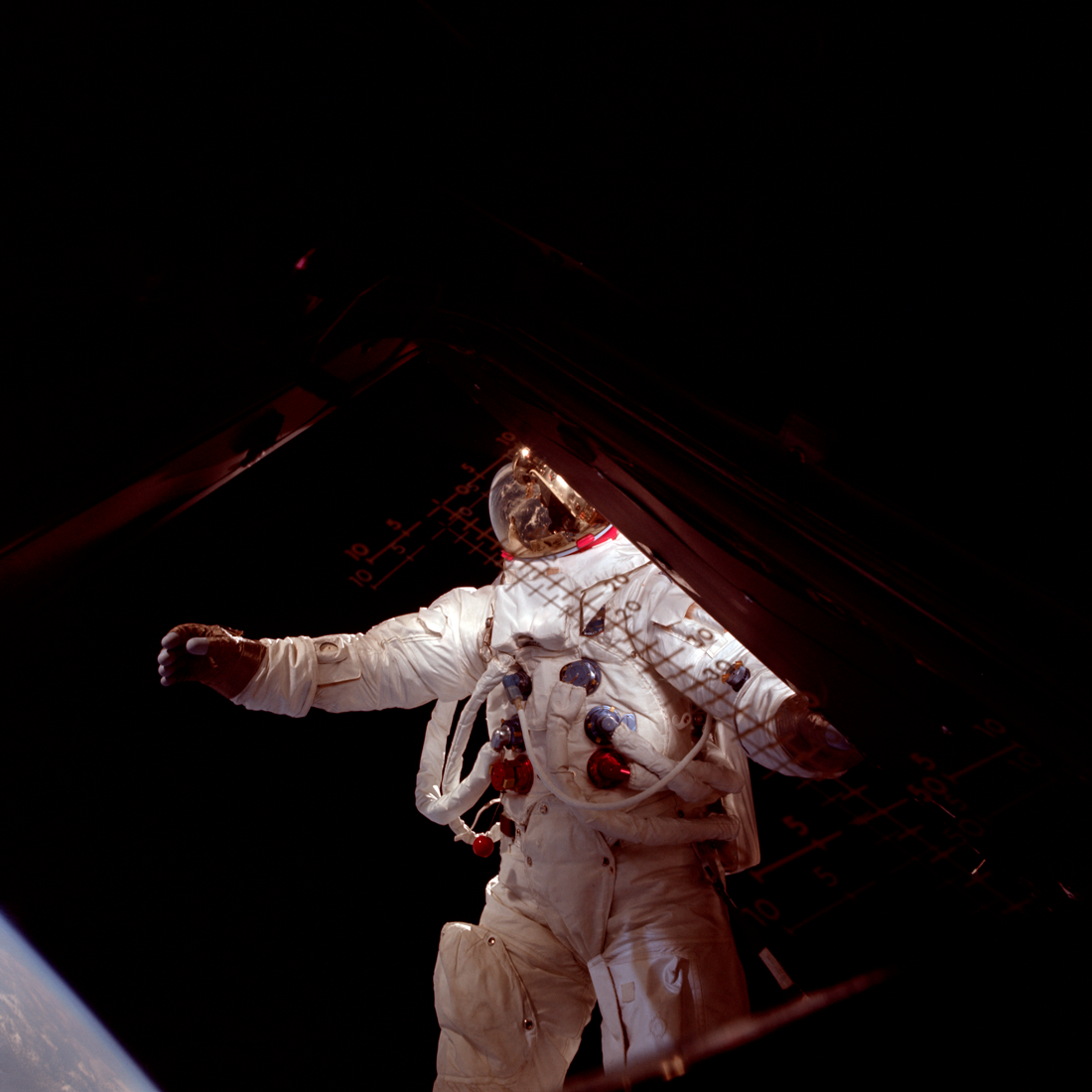
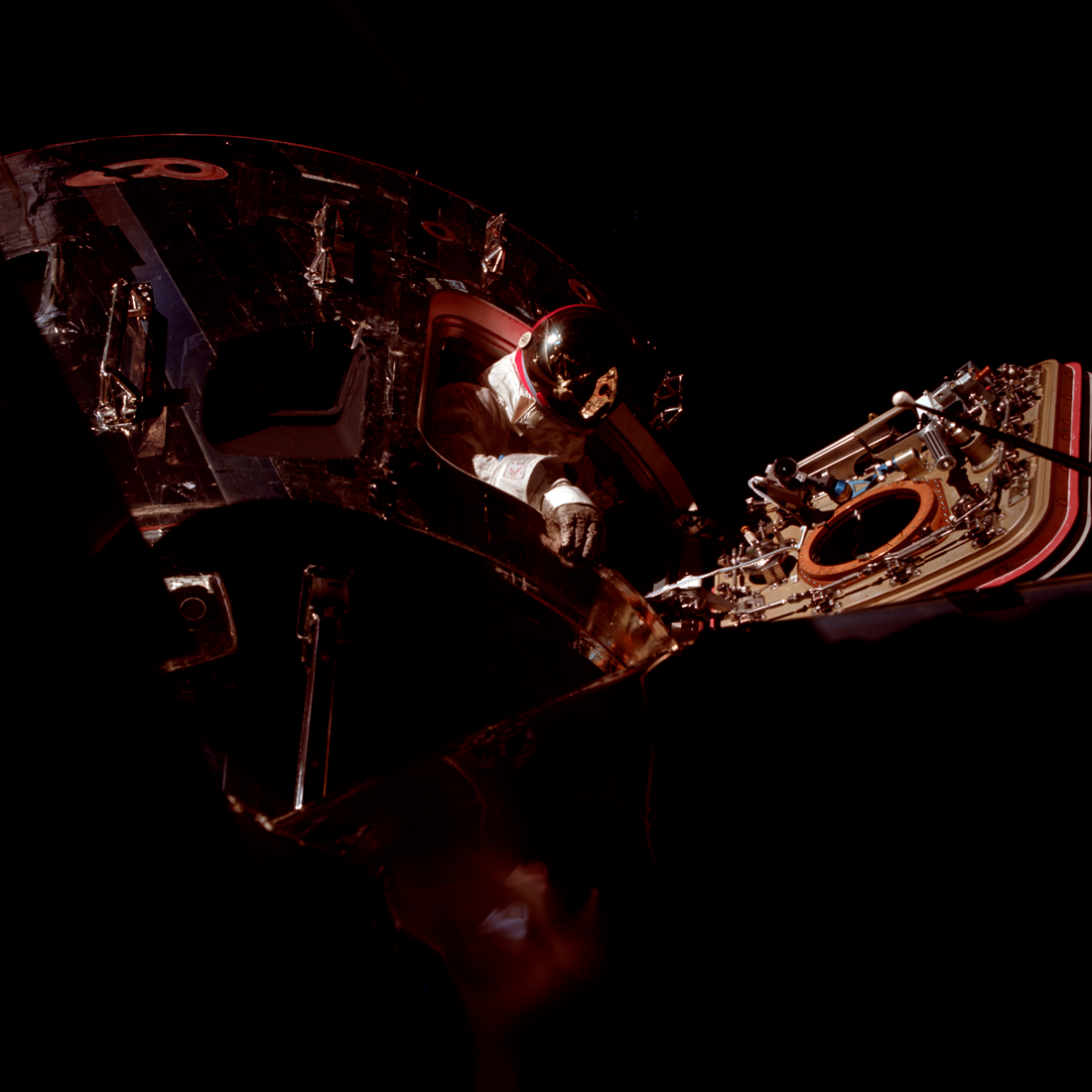
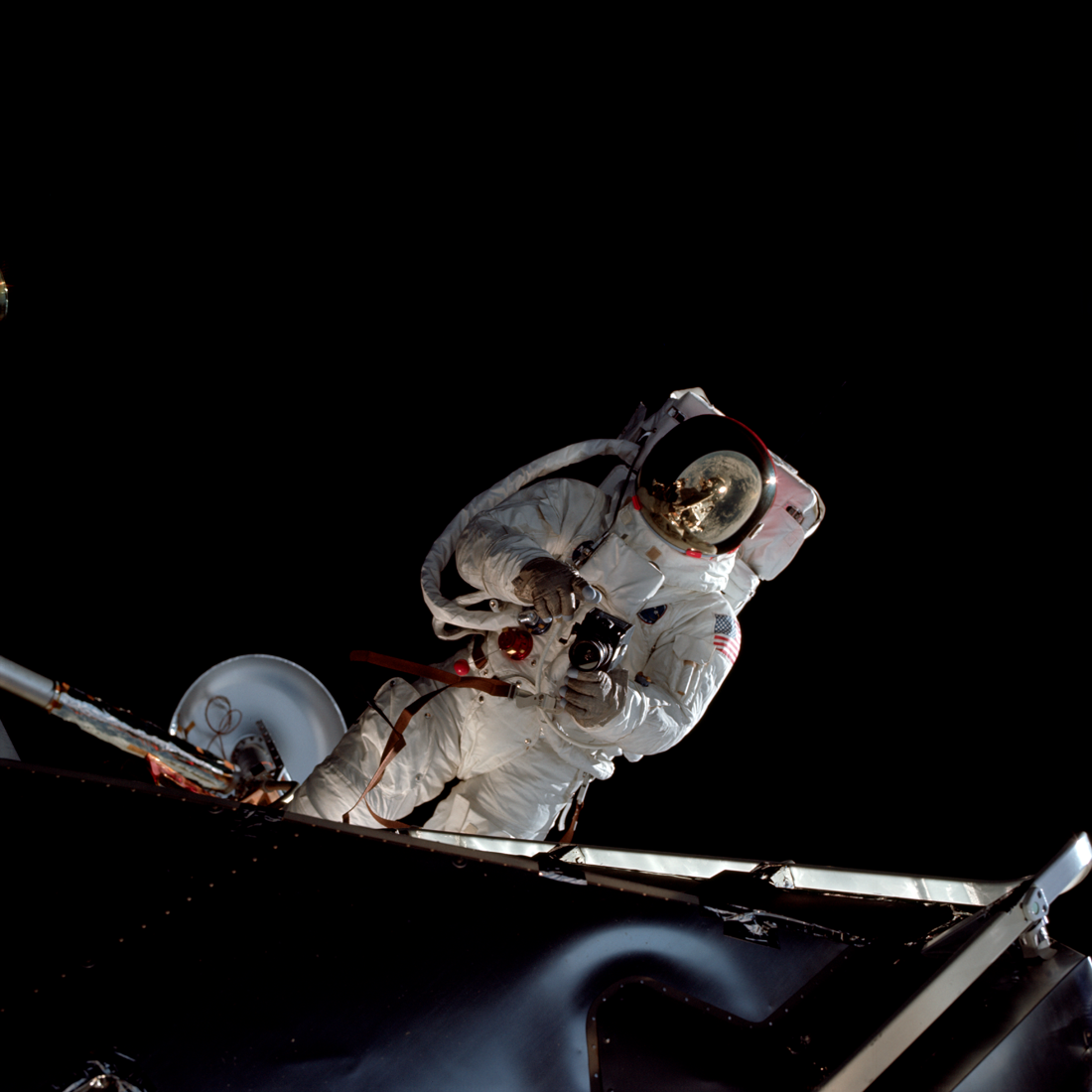
Ninety-three hours after liftoff, Spider was ready to fly free. On 7 March, Scott opened latches that held Gumdrop and Spider together and extended Gumdrop's probe docking unit. He then opened latches on the probe and fired the CSM's attitude control thrusters to back away from Spider.
McDivitt and Schweickart fired Spider's thrusters to put it into a slow spin so Scott could inspect and photograph it. The LM was the first piloted spacecraft designed to operate exclusively in the vacuum of space. Bright orbital sunlight glinted off Spider's gold-colored mylar insulation and silver aluminum surfaces. Scott radioed that the LM was "the biggest, friendliest, funniest-looking spider I've ever seen."
The astronauts fired Spider's DPS motor twice, raising their orbital altitude and falling about 120 kilometers behind Gumdrop. They then fired the APS motor and attitude-control thrusters to separate the Ascent Stage from the Descent Stage. Though not a perfect simulation of Ascent Stage liftoff from the Moon, the test gave NASA engineers confidence that their planned method of lunar liftoff would work. It also tested an abort method astronauts would use to escape to lunar orbit if the DPS failed or ran low on propellants during descent and landing. The astronauts then tested maneuvers which would in lunar orbit be used to bring the LM and CSM to within rendezvous distance.
About six hours after undocking, Gumdrop and Spider rendezvoused. McDivitt and Schweickart again maneuvered Spider — with its Descent Stage and spindly legs gone, it no longer looked very spidery — so that Scott could inspect and photograph it. Then Scott moved in to dock with the LM. McDivitt and Schweickart transfered to Gumdrop, then the crew cast off the Ascent Stage. About an hour later, controllers on Earth commanded the APS to fire until it ran out of propellants. The six-minute burn placed Spider's Ascent Stage into a 6934-kilometer-by-231-kilometer Earth orbit. The abandoned Ascent Stage would orbit Earth until 23 October 1981, when it at last reentered the atmosphere and burned up.
Spider passed its tests with flying colors. McDivitt, a long-time high-performance jet pilot, paid the LM a high compliment when he reported that it "flew like a jet." Apollo 9 cleared the way for a lunar-orbital LM test during Apollo 10, which was scheduled for launch in just two months (May 1969). If Apollo 10 was as successful as Apollo 9, then NASA would be ready to attempt its historic first lunar landing during Apollo 11 (July 1969).
It had been an action-packed five days for the Apollo 9 crew, and they still had half of their 10-day mission to go. With most spacecraft tests behind them, though, their mission became much more relaxed. It was time to turn their attention to a new activity: Earth photography.
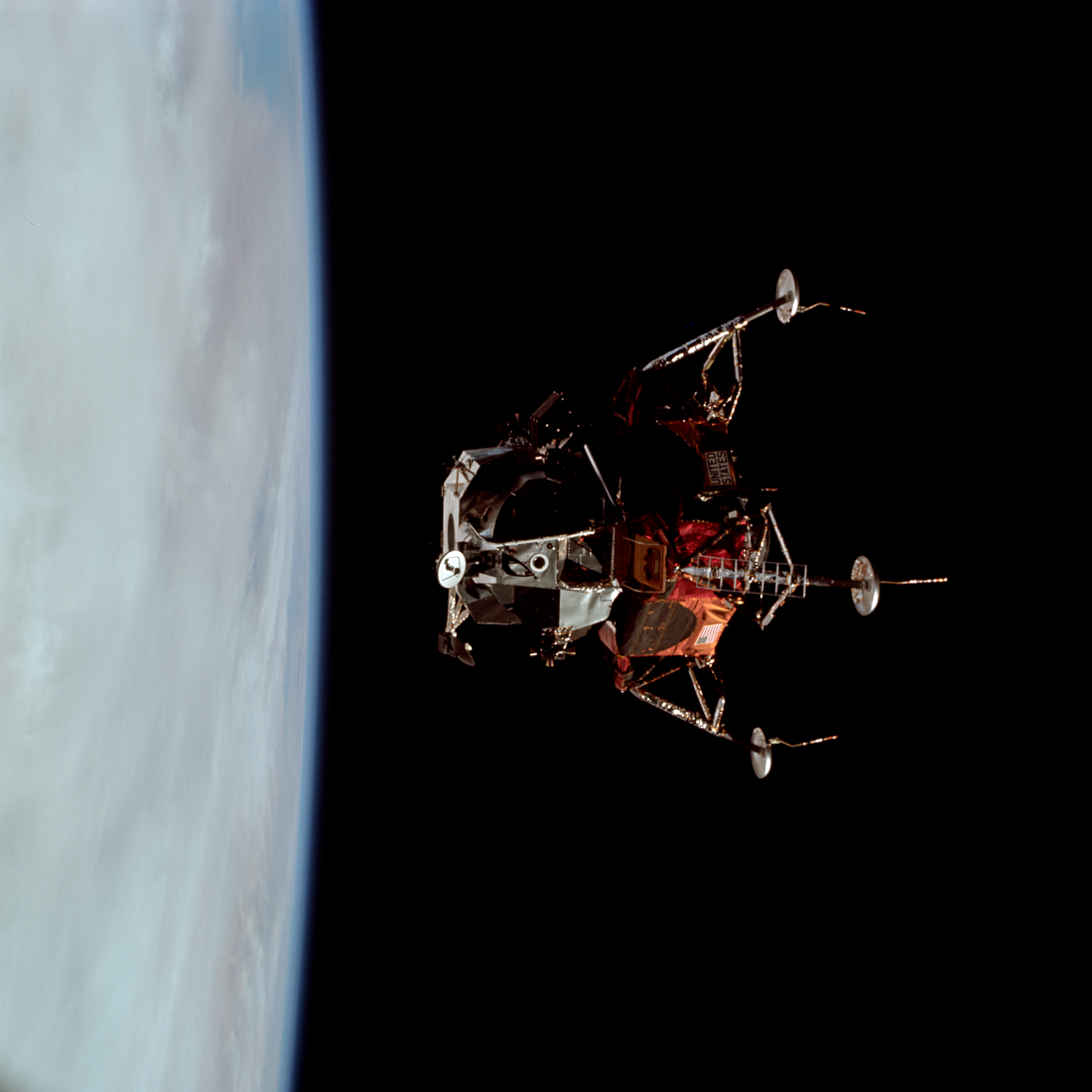
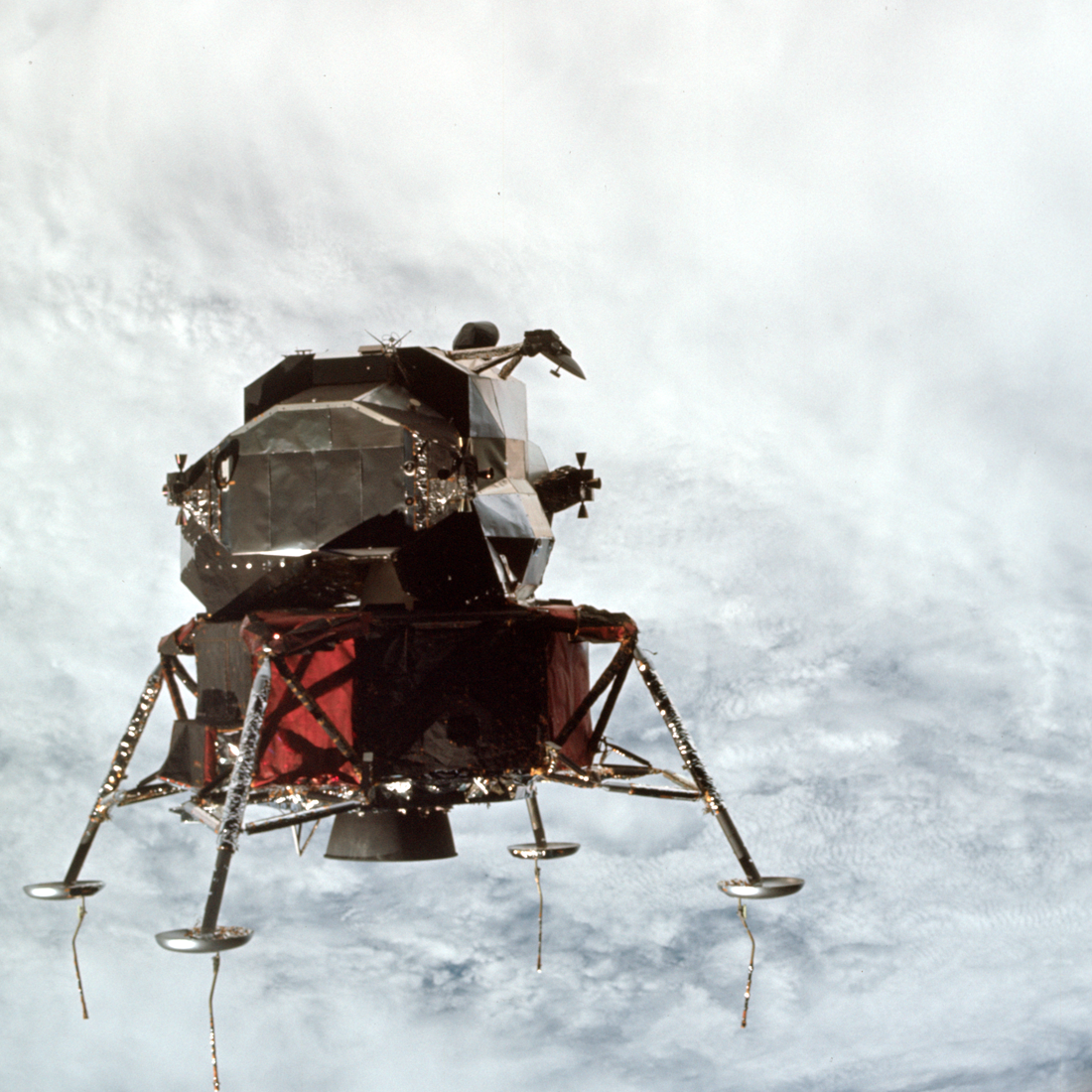
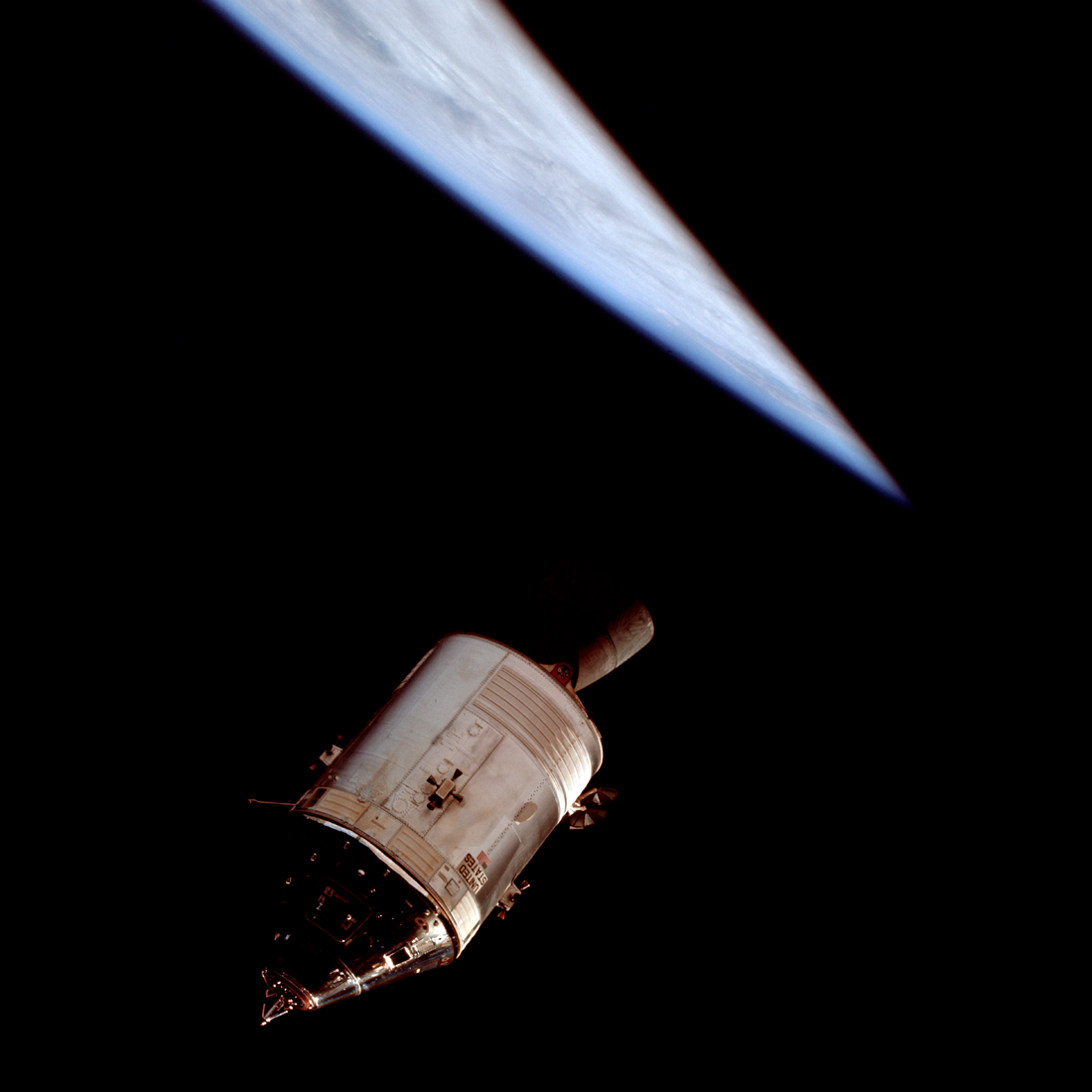
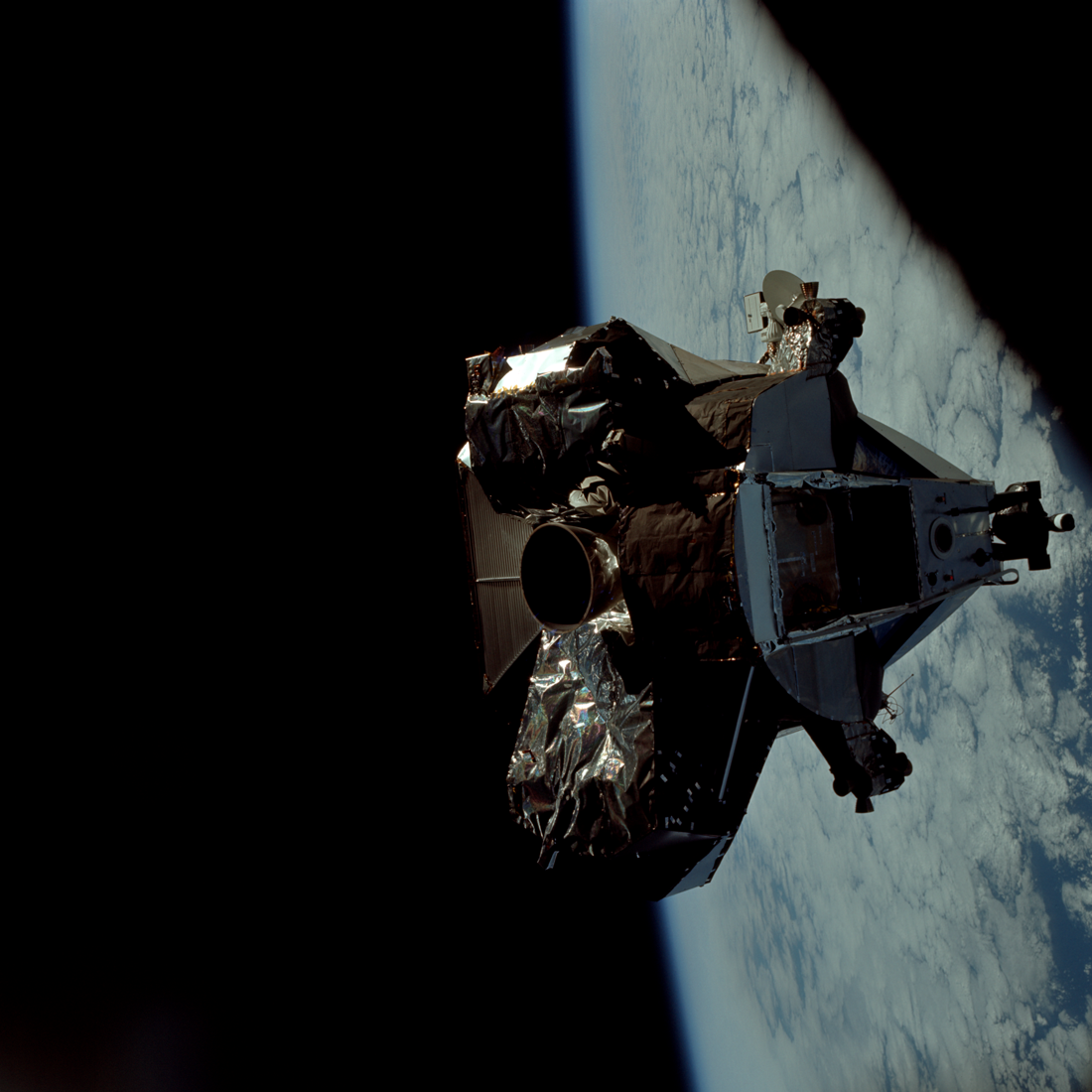
Astronauts first photographed the Earth from space during Project Mercury. During Project Gemini, they received special training so they could successfully locate and photograph geologic features. During Apollo 9, McDivitt, Scott, and Schweickart took astronaut Earth observation a step further. They used four of Apollo 9's film cameras for experiment S065, the Multispectral Terrain Photography Experiment.
Apollo 9 had the advantage over previous attempts at astronaut Earth photography because Gumdrop had plenty of attitude-control propellants in its tanks. This meant that the astronauts could carefully maneuver the CSM so that its windows pointed at their photographic targets on the ground.
Most of their targets were located in the United States, but they also photographed targets in Africa. During the Apollo 6 mission (4 April 1968), a Saturn V rocket test with no crew on board, automatic cameras had photographed the River Nile and other features. By photographing the same features nearly a year apart, the Apollo 9 crew would give scientists on Earth the opportunity to study any changes that took place over time.
Below are a few highlights from experiment S065. Many more Apollo 9 Earth photographs can be found on the LROC March to the Moon webpage.
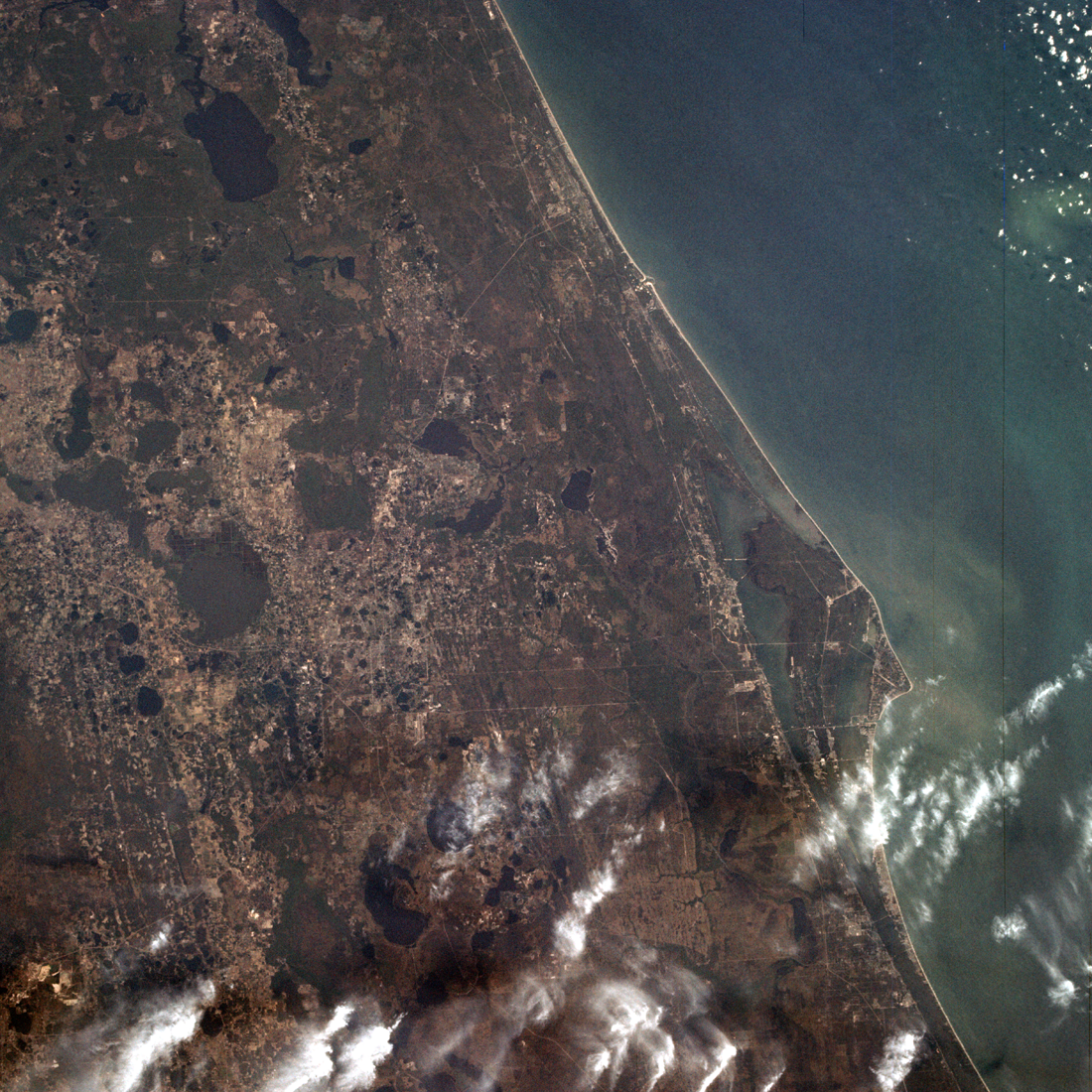
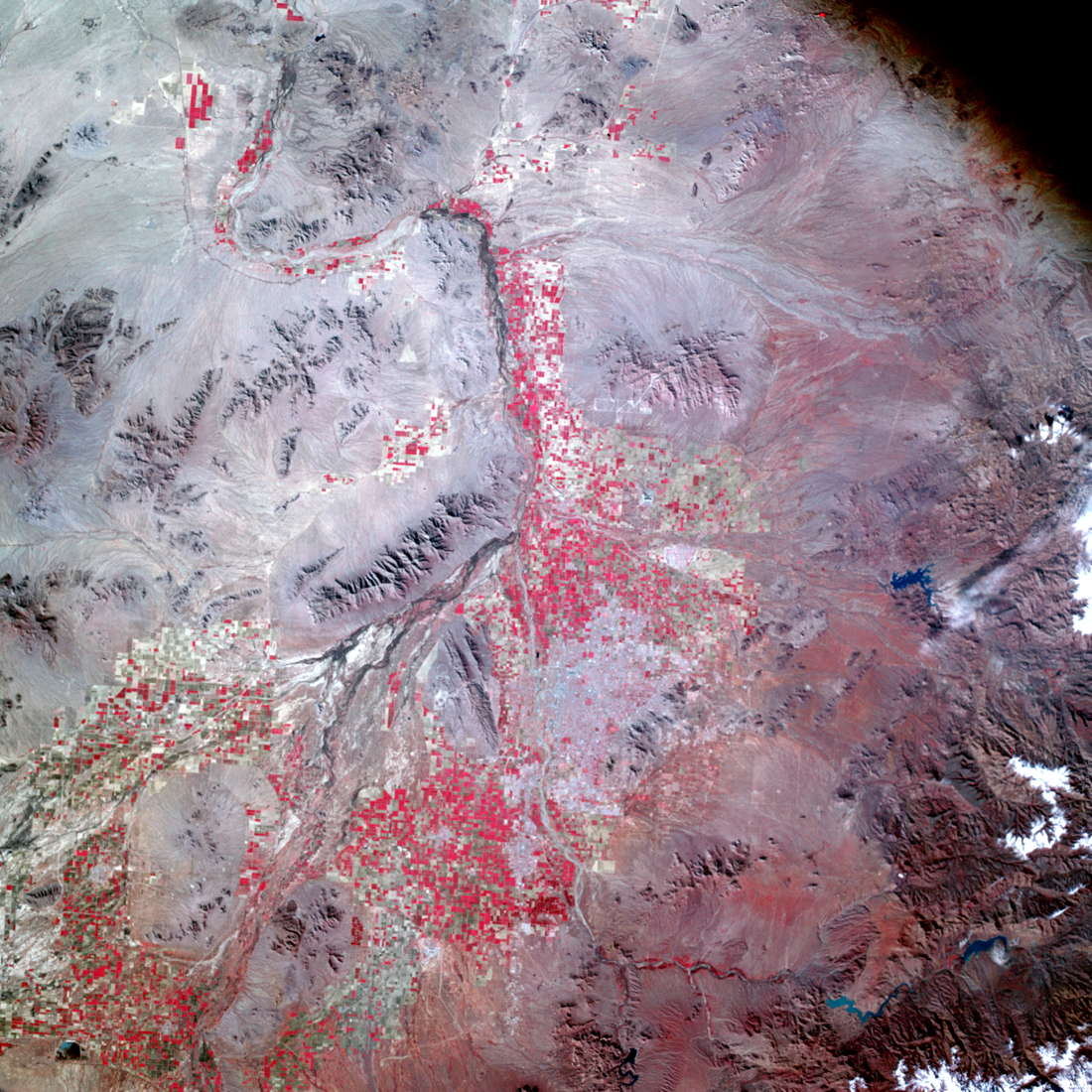
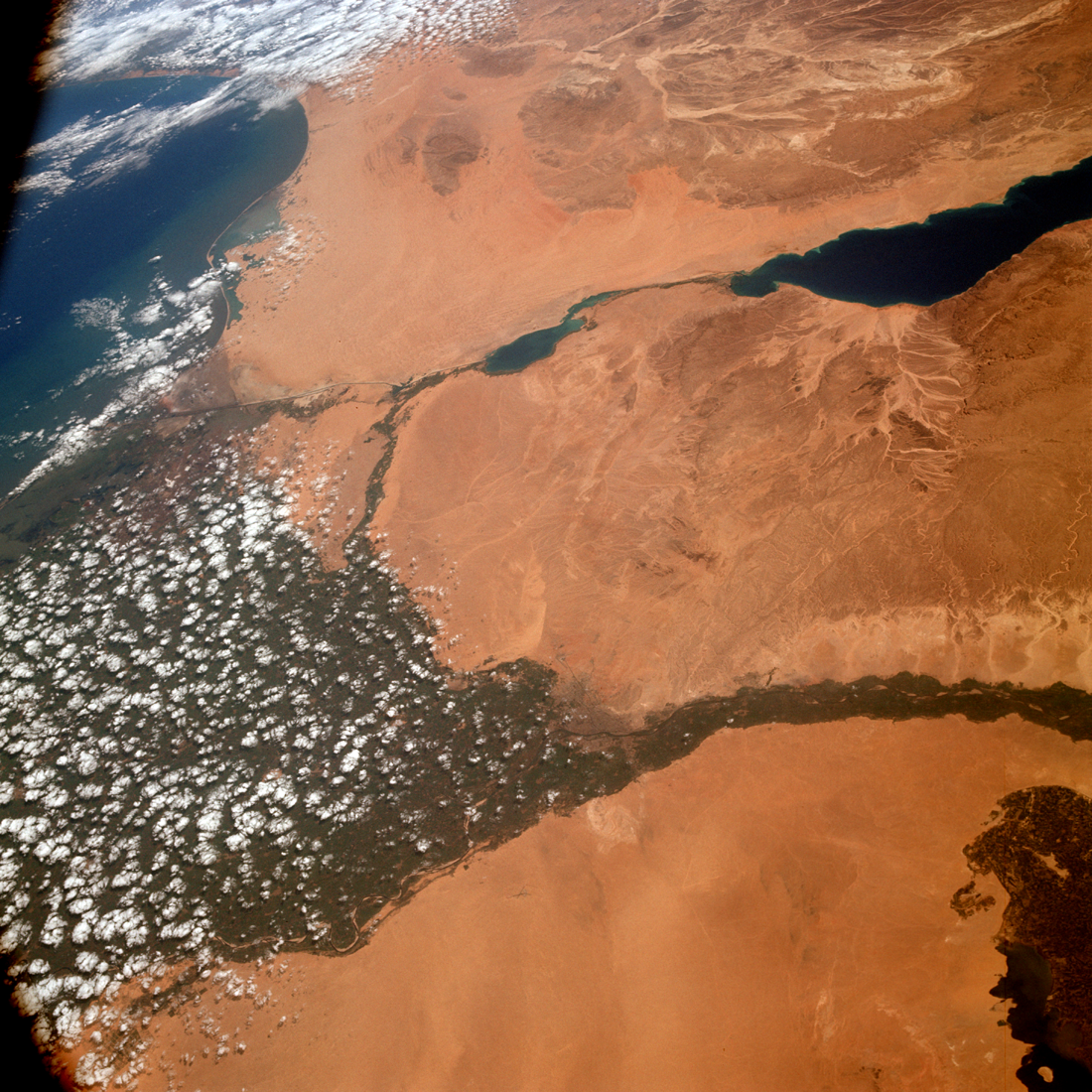
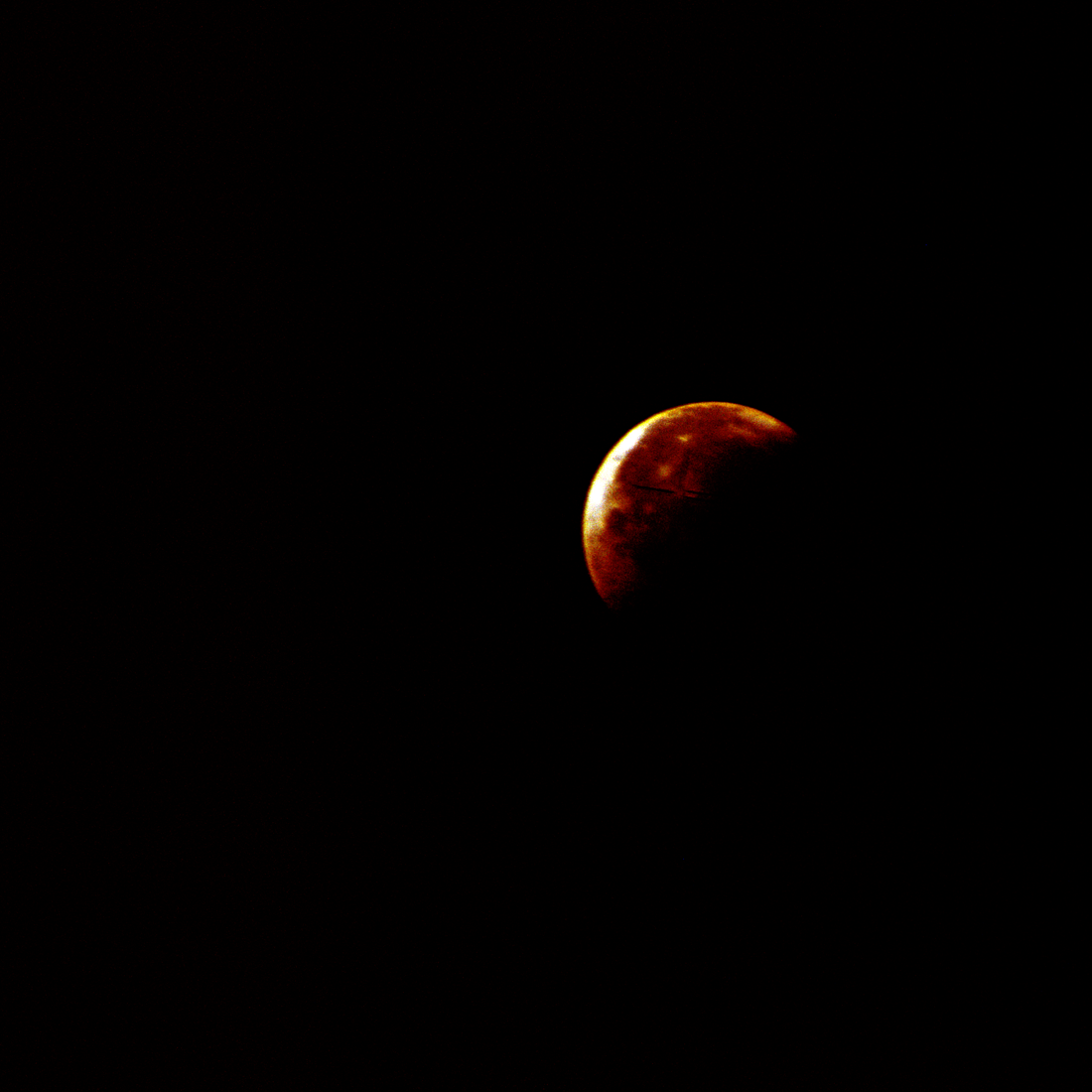
On March 13, the Apollo 9 crew was ready to return home. They had completed 151 Earth orbits, successfully tested all the major Apollo space vehicles, and recorded 584 images of the Earth as part of experiment S065.
To begin the journey home, they turned Gumdrop so that its SPS main engine pointed in its direction of flight, then ignited it for 12 seconds. About five minutes after the deorbit burn, they cast off the SM and oriented the CM with its bowl-shaped heat shield pointing forward. Earth atmosphere reentry began about eight minutes later. Fire danced outside the CM's windows. Gumdrop rolled around its center of gravity to steer toward its target splashdown point in the North Atlantic east of Florida. McDivitt, Scott, and Schweickart felt their weight increase to 3.35 times normal as drag slowed the CM.
Twenty-four minutes after the deorbit burn, Gumdrop deployed three orange and white parachutes. Five minutes later, after leisurely drifting over the Atlantic, the scorched CM splashed down just 5.5 kilometers from the main recovery ship, the USS Guadalcanal.
After the successful Apollo 9 flight, the Moon seemed very close. There was just one more mission scheduled before NASA's first Moon landing attempt: the lunar-orbital LM test of Apollo 10.
Sources:
Apollo 9 Mission Report, MSC-PA-R-69-2, NASA Manned Spacecraft Center, May 1969
Code-Name: Spider — Flight of Apollo 9, NASA EP-66, 1969
Press Kit, Project: Apollo 9, Release No. 69-29, NASA Headquarters, 14 February 1969
Email, Paolo Attivissimo to David S. F. Portree, 5 February 2019
Featured Images Related to the Post:
Apollo 7: 50 Years Ago
First to See the Farside
Mount Marilyn: A Lunar Love Story
Apollo 11 Footsteps
Posted by David Portree on *Post not yet published.
Tweet
|
|
Space Exploration Resources |
|
 LPI LPI
|